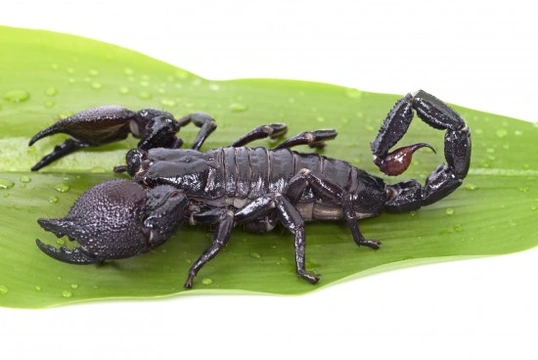
Caring for an Emperor scorpion
The Emperor scorpion is native to Africa, and is one of the largest scorpion species in the world. They are one of the most popular pet scorpions within the UK, but they should still be handled with a significant amount of respect! They are one of the more docile scorpion species, although like all scorpions, they should not be handled unless absolutely necessary. The sting of the Emperor scorpion, while painful, is generally no more potent than that of the wasp.
They are black in colour, but interestingly, they glow under ultraviolet light. They are also a pet for those who are looking for a scorpion for the long term, as they commonly live for six to eight years. If you are considering keeping an Emperor scorpion as a pet and want to learn more about their care, housing and feeding requirements, read this introduction to caring for an Emperor scorpion.
How many to keep?
The Emperor scorpion is not a sociable creature, and they should be kept individually to avoid fighting! Breeding Emperor scorpions is a process to be undertaken carefully, as a male and female are as likely to fight as they are to breed if introduced to each other by an inexperienced keeper.
Housing and humidity
A single Emperor scorpion can be kept in either a vivarium or faunarium of around two feet long by a foot high and deep. They require a substrate similar to that of a forest floor, composed of additive-free peat and a suitable bark (such as orchid bark) around two to three inches deep. The Emperor scorpion likes to burrow, and will most commonly make their burrows at the cooler end of their tank. You will of course also need to ensure that you have a suitably secured lid for the tank!
Emperor scorpions need a reasonably high level of humidity in their tank to thrive, and so you should mist the substrate lightly every day with clean, fresh water. They will also require a water dish with a sponge in it, filled with clean, fresh water.
Heating and lighting the tank
The Emperor scorpion is nocturnal, and does not require sunlight to thrive. However, providing a UVB light on a timer can be beneficial to provide the effect of a day and night cycle within the tank, and to make it easier for the owner to observe their scorpion in what would otherwise be a rather dark enclosure.
An infrared heat lamp at one end of the tank is the best way of catering to the Emperor scorpion’s lighting and heating requirements, to provide a constant temperature of between 25 and 28 degrees Celsius, with a basking area (which will be the part nearest to the heat lamp) of around 30 degrees Celsius also available.
Feeding an Emperor scorpion
The Emperor scorpion is insectivorous, and eats live food such as black and brown crickets as the main part of its diet, occasionally supplemented by treats such as mealworms and other creepy crawlies. Live foods of these types are readily available to buy from most pet shops, or online retailers who deliver live insects through the post.
Exactly how much your Emperor scorpion eats will depend on their size and age, but a very broad rule is to feed them three times a week, and expect them to consume up to five or six crickets each time when fully grown.
It is important not to overfeed your Emperor scorpion, or leave uneaten food rotting in the tank. Also, take care that the insects that you feed are not too large for your scorpion to manage, as they might fight back!
Live food for scorpions will need to be gutloaded with a high-protein compound, to ensure that they fulfil all of the nutritional requirements of your scorpion. Scorpions also require calcium in order to keep their exoskeleton hard and healthy, and this may be provided by dusting live food with a calcium supplement before feeding your scorpion on occasion.
Working around your Emperor scorpion
Handling scorpions should be kept to a minimum, but nevertheless, sometimes you will need to put your hands into the tank or move your scorpion around, and it is important to do this safely! As well as of course, the sting in the tail, scorpions may bite or pinch with their claws, so they really do have a wide range of defences at their disposal.
If possible, do not put your hands into the tank; use long handled tweezers to remove uneaten food. If you need to move your scorpion or remove them from the tank, try to corral them using a small plastic container and lid, and secure them inside of this to remove them without handling them at all, if possible.
If you do need to physically pick your scorpion up, using a pair of long handled tongs or blunt tweezers is recommended, grasping your scorpion by the tail, just below the sting. Make sure you have a firm but not crushing hold of them in this manner before lifting them out of the tank, to avoid dropping them!



